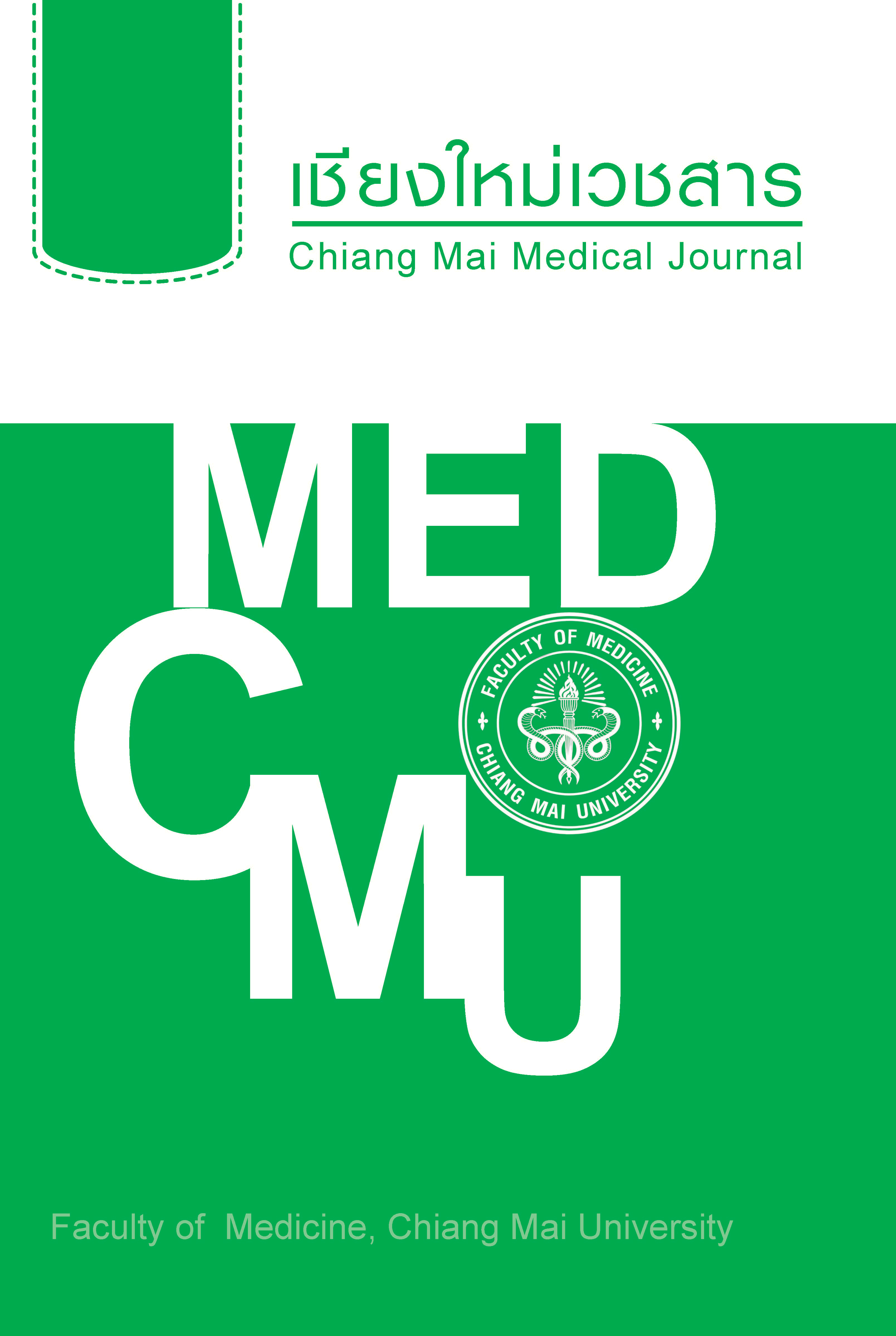Clinicopathological Study of Kimura disease and Angiolymphoid hyperplasia with eosinophilia in patients at Maharaj Nakorn Chiang Mai Hospital
Keywords:
Kimura disease, Angiolymphoid hyperplasia with eosinophiliaAbstract
Objective To evaluate clinicopathologic differences between Kimura disease (KD) and angiolymphoid hyperplasia with eosinophilia (ALHE)
Methods Clinical data and pathological slides of KD and ALHE patients at Maharaj Nakorn Chiang Mai Hospital from 1999 through 2011 were retrieved and analyzed.
Results A total of 32 KD patients (21 males; 11 females) age 2-74 years (mean 36.44) presented with a painless mass (size 0.4-10 cm; mean 3.75) in the head and neck region had been treated during the study period. The masses had been present for between 1 and 228 months (mean 28.27). There were also 19 ALHE patients (13 males; 6 females) age 1-66 years (mean 32), most of whom had a fi rm, painless mass (n=14) measuring 0.2-3 cm (mean 1.09). Of the ALHE cases, one had a cystic lesion, 2 had indurated skin and 2 had nasal obstruction. Duration of symptoms in the ALHE patients ranged from 1 to 36 months (mean 8.63). Presentation with a painless mass was a signi fi cant clinical diagnostic for KD (p =0.005). Differences in histologic fi ndings between KD and ALHE included the presence of lymphoid follicles in KD (p <0.000) and the extension of KD into deep subcutaneous tissue, salivary glands and skeletal muscle (p =0.029).
Conclusions KD was found in female and middle-aged patients, not just young males as previously reported. Conditions which would indicate the presence of KD rather than ALHE include presentation with a mass, pathologic fi ndings of lymphoid follicles and extension into the deep subcutaneous tissue, skeletal muscle and salivary gland.
References
Kim HT, Szeto C. Eosinophilic hyperplastic lympho-granuloma, comparison with Miculicz’s disease. Chin Med J. 1937;23:699-700.
Kimura T, Yoshimura S, Ishikawa E. On the unusual granulation combined with hyperplastic changes of lymphatic tissues. Trans Soc Pathol Jpn. 1948; 37:179-80.
Chen H, Thompson LD, Aguilera NSI, Abbondanzo SL. Kimura disease: a clinicopathologic study of 21 cases. The American journal of surgical patho-logy. 2004;28:505-13.
Larroche C, Bletry O. Kimura’s disease. Orphanet encyclopedia, February. 2005.
Li T-J, Chen X-M, Wang S-Z, Fan M-W, Semba I, Kitano M. Kimura’s disease: a clinicopathologic study of 54 Chinese patients. Oral Surgery, Oral Medicine, Oral Pathology, Oral Radiology, and Endodontology. 1996;82:549-55.
Shetty AK, Beaty MW, McGuirt WF, Woods CR, Givner LB. Kimura’s disease: a diagnostic chal-lenge. Pediatrics. 2002;110:e39-e.
Yuen H, Goh Y, Low W, Lim-Tan S. Kimura’s disease: a diagnostic and therapeutic challenge. Singa-pore Med J. 2005;46:179.
Wells G, Whimster I. Subcutaneous angiolym-phoid hyperplasia with eosinophilia. Br J Derma-tol. 1969;81:1-15.
Ingrams D, Stafford N, Creagh T. Angiolymphoid hyperplasia with eosinophilia. The Journal of Laryngology & Otology. 1995;109:262-4.
Kung IT, Gibson J, Bannatyne P. Kimura’s disease: a clinico-pathological study of 21 cases and its distinction from angiolymphoid hyperplasia with eosinophilia. Pathology. 1984;16:39-44.
Ramchandani PL, Sabesan T, Hussein K. Angio-lymphoid hyperplasia with eosinophilia masquer-ading as Kimura disease. Br J Oral Maxillofac Surg. 2005;43:249-52.
Chartapisak W, Opastirakul S. Steroid-resistant nephrotic syndrome associated with Kimura’s dis-ease. Am J Nephrol. 2002;22:381-4.
Chitapanarux I, Ya-In C, Kittichest R, Kamnerdsu-paphon P, Lorvidhaya V, Sukthomya V, et al. Ra-diotherapy in Kimura’s disease: a report of eight cases. J Med Assoc Thai. 2007;90:1001-5.
Linwong M, Rasmidat S, Vachirachewin P, Jirura-wong N. Angiolymphoid hyperplasia with eosino-philia. J Med Assoc Thai. 1990;73:458-61.
Kabashima R, Kabashima K, Mukumoto S, Hino R, Huruno Y, Kabashima N, et al. Kimura’s disease presenting with a giant suspensory tumor and asso-ciated with membranoproliferative glomerulone-phritis. Eur J Dermatol. 2009;19:626-8.
Sun QF, Xu DZ, Pan SH, Ding JG, Xue ZQ, Miao CS, et al. Kimura disease: review of the literature. Intern Med J. 2008;38:668-72.
Chan J, Hui P, Ng C, Yuen N, Kung I, Gwi E. Epithelioid haemangioma (angiolymphoid hyper-plasia with eosinophilia) and Kimura’s disease in Chinese. Histopathology. 1989;15:557-74.
Chong WS, Thomas A, Goh CL. Kimura’s disease and angiolymphoid hyperplasia with eosinophilia: two disease entities in the same patient. Case re-port and review of the literature. Int J Dermatol. 2006;45:139-45.
Googe P, Harris N, Mihm M. Kimura’s disease and angiolymphoid hyperplasia with eosinophilia: two distinct histopathological entities. J Cutan Pathol. 1987;14:263-71.
Downloads
Published
How to Cite
Issue
Section
License
Copyright (c) 2017 Chiang Mai Medical Journal

This work is licensed under a Creative Commons Attribution 4.0 International License.








